Bruce Springsteen’s Fall 2025 appearance on the cover of TIME magazine provides an opportunity to reflect on the first time he graced that illustrious publication’s cover 50 years ago, in the Fall of 1975. That cover, which featured a striking portrait of him beneath the bold headline “Rock’s New Sensation,” signaled both the culmination of years of struggle and the beginning of a new chapter. It remains one of the most iconic intersections of music and media in the twentieth century—especially as Bruce appeared on the cover of Newsweek simultaneously. As I tell my students here at Monmouth University—it was the 1975 equivalent of going viral on social media.
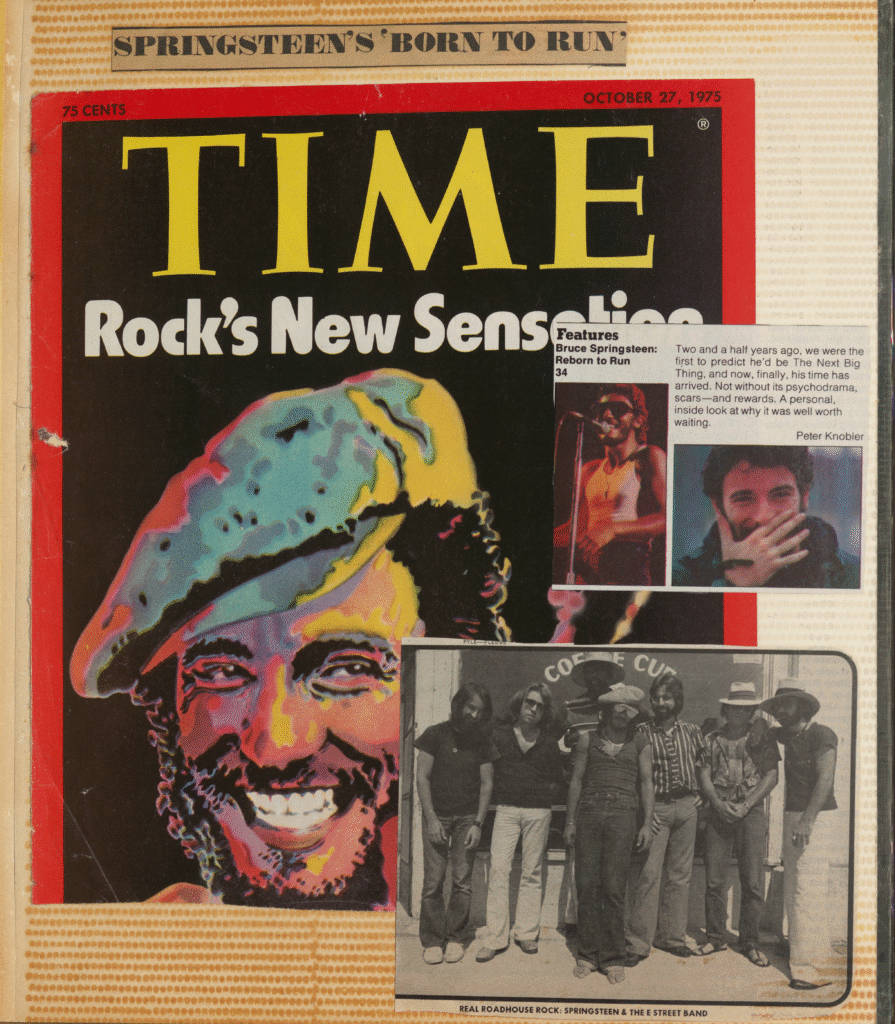
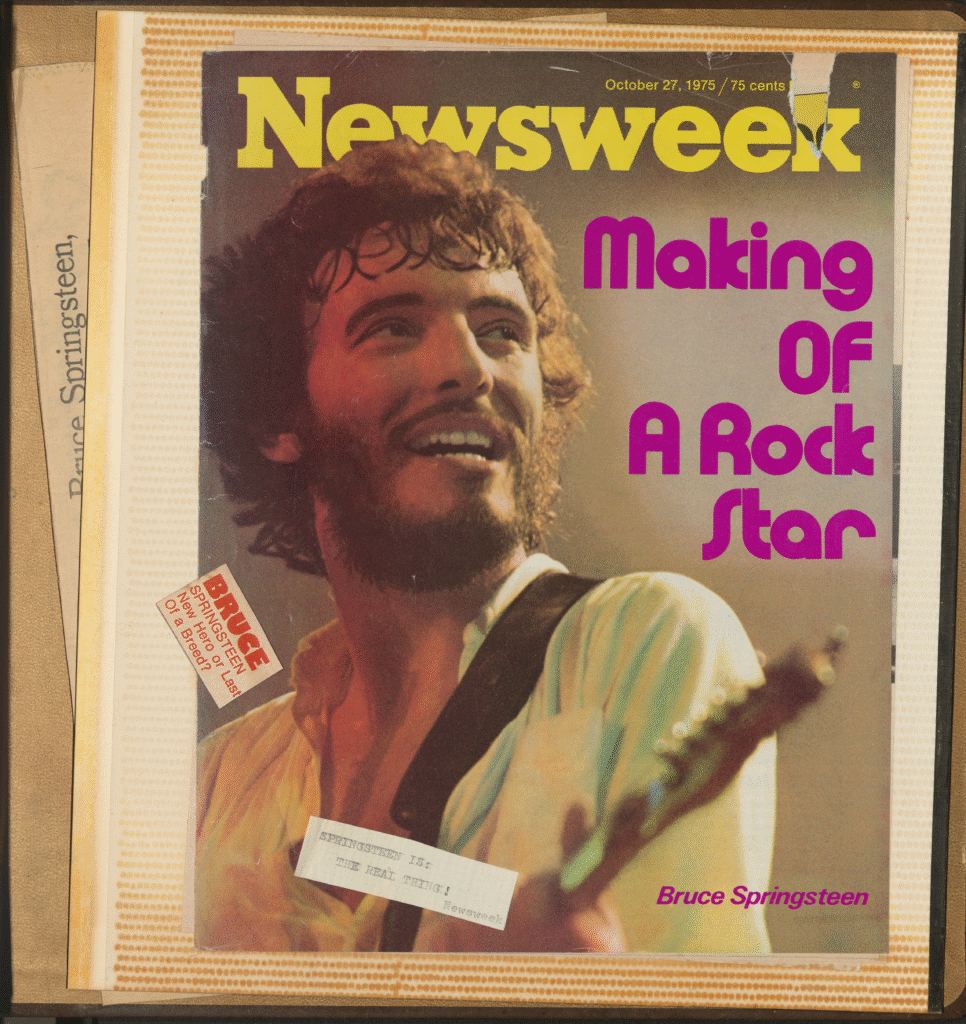
The covers as seen in a scrapbook kept by Bruce’s mother, Adele. Courtesy Bruce Springsteen Archives & Center for American Music.
The Road to TIME
By the Fall of 1975, Springsteen’s career was at a crossroads. Signed to Columbia Records in 1972, he had already released two albums—Greetings from Asbury Park, N.J. and The Wild, the Innocent & the E Street Shuffle.
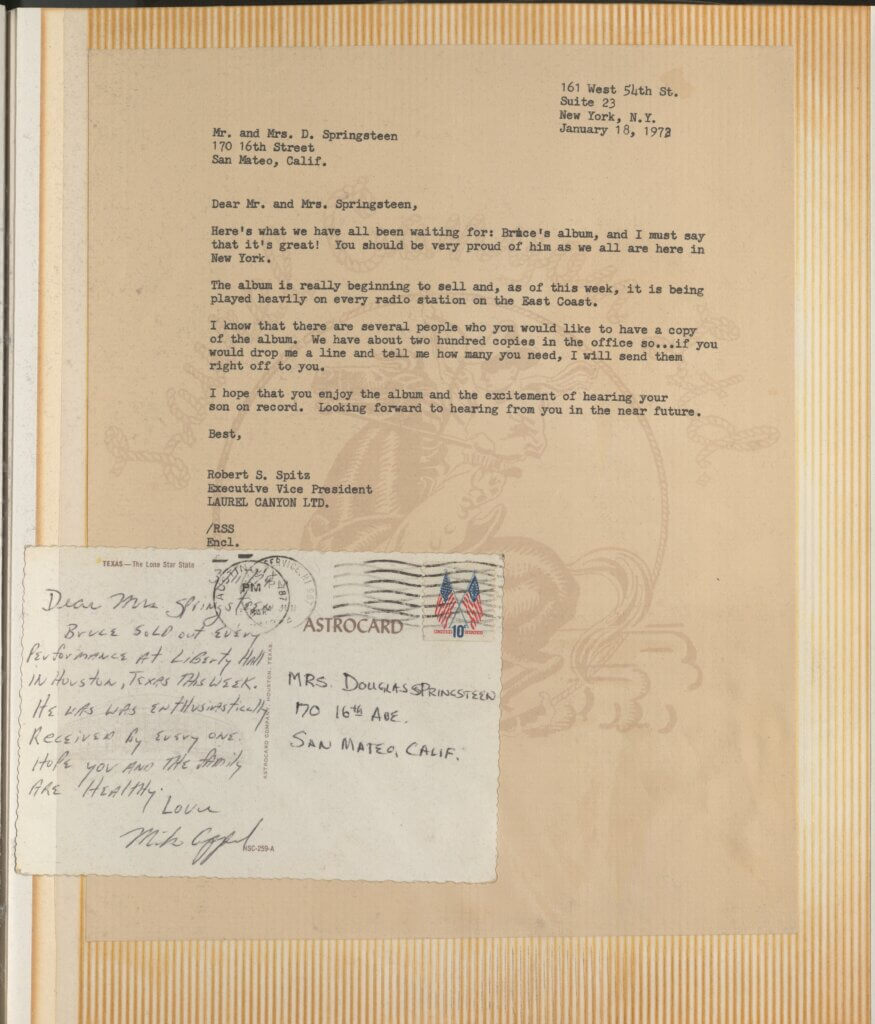
Correspondence following the release of Greetings from Asbury Park, N.J., in a scrapbook kept by Bruce’s mother, Adele. Courtesy Bruce Springsteen Archives & Center for American Music.
Columbia had high hopes for both albums, but, while they received largely positive reviews, they struggled commercially. Industry insiders had touted Bruce as a promising new voice, even calling him the next Bob Dylan, but he failed to catch on with a wider audience. Springsteen faced pressure from Columbia to deliver a hit, or risk being dropped.
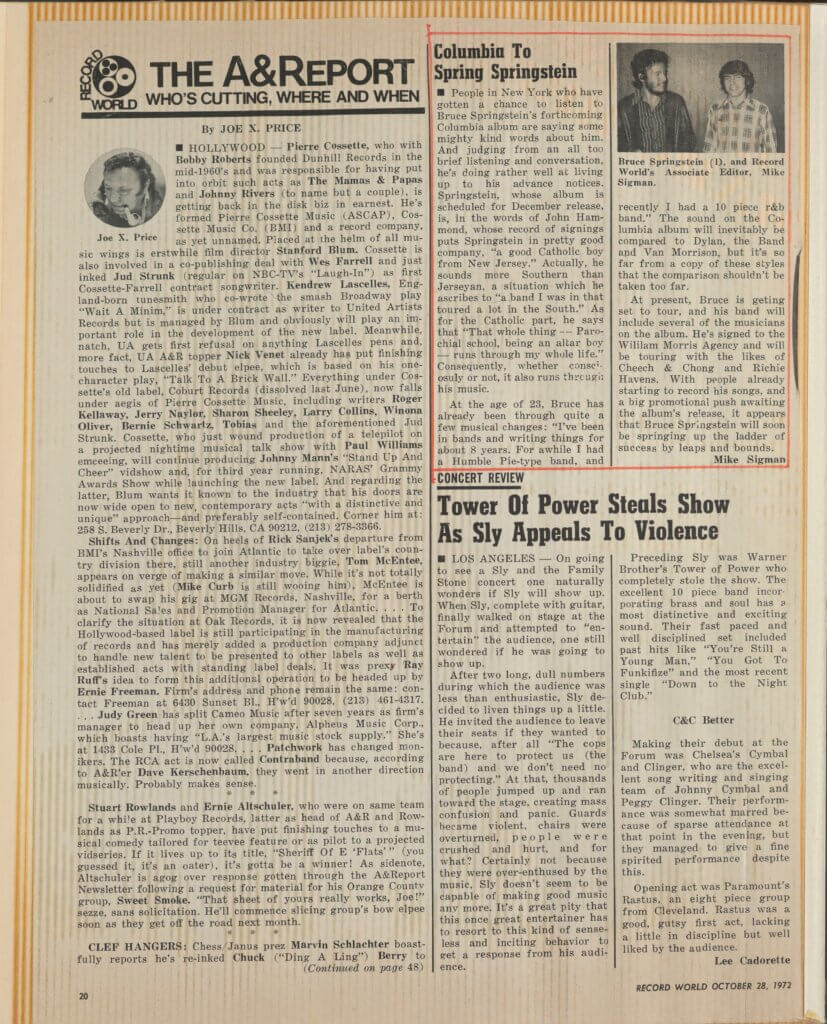
Article in a scrapbook kept by Bruce’s mother, Adele, refuting the now famous Bob Dylan references. Courtesy Bruce Springsteen Archives & Center for American Music.
Luckily for Springsteen, a breakthrough came in August 1975 with Born to Run. The album’s lush, cinematic sound and its themes of youthful desperation and escape resonated with broader audiences than Springsteen’s earlier work had. The single “Born to Run” caught fire on radio, and Bruce’s concerts—already legendary at the Jersey Shore—gained a national reputation for their intensity. Word of mouth spread quickly: here was an artist who seemed to embody both rock’s past traditions and its future potential. Many critics hailed him as the savior of rock and roll at a time when the genre was perceived to be stagnating.
It was against this backdrop that TIME magazine—one of the most influential publications in the country—took notice. Along with Newsweek, its weekly rival, TIME helped define the mainstream narrative of American culture. For Springsteen to appear on the cover was not just a nod to his popularity; it was a declaration that he mattered far beyond the world of just rock music fans.
The October 27, 1975 Cover
The TIME cover was visually simple but powerful. Photographed by Barbara Pyle, Springsteen’s face stared directly at the reader, framed by a soft light that emphasized his youthful features. He looked both intense and approachable, rugged yet vulnerable. The caption, “Rock’s New Sensation,” positioned him as more than just another artist on the charts—it made him a phenomenon.
Barbara Pyle at our Born to Run 50th anniversary symposium, September 6. Photo by Mark Krajnak.
The article accompanying the TIME cover, written by Jay Cocks, was effusive in its praise. It described Springsteen as an authentic voice of working-class America, a poet who fused the grit of street life with the grand sweep of American dreams. Cocks noted that Springsteen’s concerts felt less like shows and more like revivals, with audiences swept up in his boundless energy and emotional commitment. The piece emphasized not just his musicality but his cultural significance, presenting him as a figure who embodied both nostalgia for simpler times and hope for a renewed rock spirit.
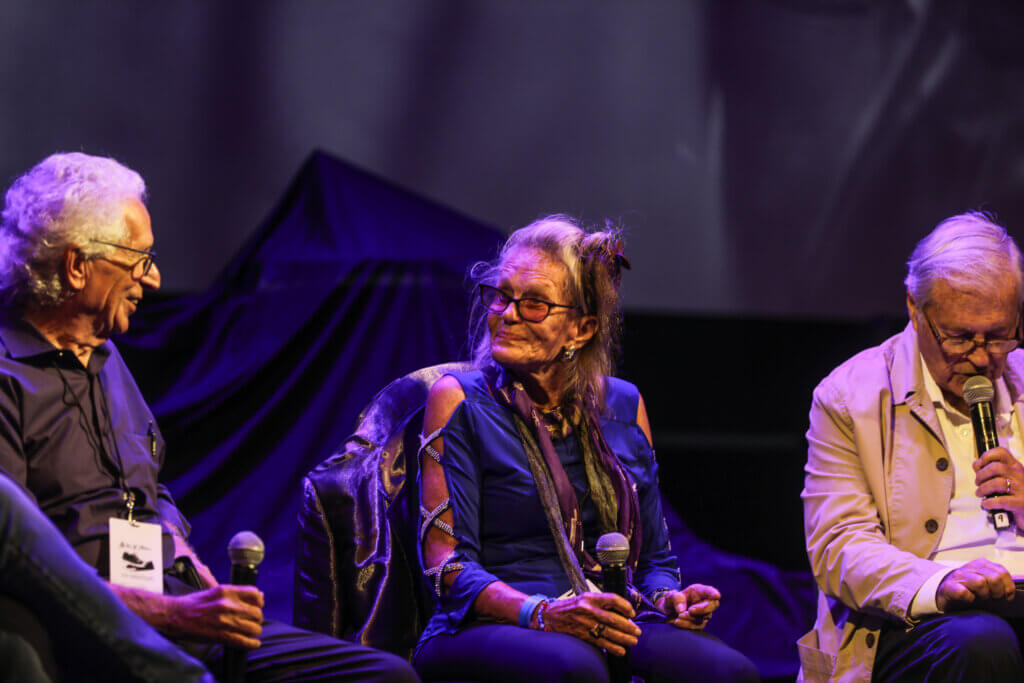
As noted at the outset of this piece, it was truly remarkable that, the very same week, Newsweek also ran a cover story on Springsteen. The simultaneous coverage by both magazines was unprecedented for a musician, let alone one so relatively early in his career. The dual spotlight cemented Springsteen’s status as a national figure. Suddenly, he was not only a musician but a cultural symbol, someone whose story carried weight in the larger narrative of American life.
The Impact on Springsteen’s Career
For Springsteen, the TIME cover was both a blessing and a burden. On one hand, it gave him a platform that few artists ever achieve. His record sales skyrocketed, and demand for tickets to his concerts surged. Suddenly, he was no longer just a regional act from New Jersey; he was a household name across the United States. The exposure helped transform Born to Run into a classic, ensuring that his career would not only survive but thrive.
Yet the attention also brought challenges. Springsteen later reflected on how uncomfortable he felt with the hype. Being branded as “rock’s new sensation” was a heavy mantle, one that risked alienating him from audiences if he couldn’t live up to it. Critics began to question whether he was truly as revolutionary as the magazines claimed. The pressure to deliver grew immense, and Springsteen became wary of being turned into a media creation rather than an artist in control of his own destiny. (This inner turmoil would come to a head around the recording of the album Nebraska, released in 1982 and subject of the forthcoming major motion picture Springsteen: Deliver Me from Nowhere.)
Indeed, the timing of the TIME and Newsweek covers was ironic: Springsteen himself was still fighting with his management and wrestling with the direction of his career. He often joked that the headlines exaggerated his fame. But despite his ambivalence, there was no turning back. The TIME cover had elevated him to the top tier of American cultural icons.
Cultural and Historical Significance
As a curator, I feel compelled to note that the 1975 TIME cover must also be understood in the broader context of the era. America in the mid-1970s was grappling with disillusionment in the wake of Watergate, the Vietnam War, and economic uncertainty. Trust in institutions had eroded, and many young people sought meaning through cultural rather than political outlets. Music—especially rock—offered both escape and connection.
Springsteen’s story fit perfectly into this moment. He was not a glamorous celebrity or a detached superstar; he was a scrappy kid from the working-class streets of New Jersey who sang about ordinary struggles with extraordinary passion. His songs captured both the frustration and the possibility of the American dream, themes that resonated with a public eager for authenticity.
By putting Springsteen on its cover, TIME signaled that he was more than just an entertainer. He was portrayed as a voice of his generation, someone whose art reflected broader social realities. This was significant because TIME rarely put rock musicians on its cover. When it did, it was usually because they represented something larger than music: for example, the Beatles as cultural revolutionaries in September 1967, or Bob Dylan as a poet of protest in January 1965.
The Legacy of the Cover
Looking back, the 1975 TIME cover has become one of the defining images of Springsteen’s career. It marks the moment when he transitioned from king of the Jersey Shore bar bands to a cultural institution. While he would go on to release many more acclaimed albums, the TIME cover stands as a symbolic turning point.
For fans, it is often remembered as the moment the rest of the world discovered what they already knew: that Springsteen was special. And for critics, it remains a case study in how media can construct and accelerate an artist’s image.
Today, the cover is frequently cited in retrospectives about Springsteen’s career and about 1970s rock more broadly. It captures the excitement of discovery, the sense that a new star had arrived with the potential to reshape the landscape. It also reflects the power of print media in an era before the internet, when a magazine cover could help change the trajectory of a career seemingly overnight.
Bruce Springsteen’s appearance on the cover of TIME magazine in October 1975 was more than just a publicity coup. It was a cultural event that crystallized his ascent from struggling musician to national icon. Coming just after the release of Born to Run, it ensured that his breakthrough would not be fleeting but lasting. At the same time, it introduced him to the burdens of fame and the challenge of living up to lofty expectations.
In the decades since, Springsteen has proven that the hype was justified. His career has spanned half a century, his songs have become primary sources documenting American life, and his live performances remain legendary (having just wrapped an international tour at 75 years young). But the TIME cover remains a singular moment: the instant when the young dreamer from New Jersey was thrust into the spotlight and invited to carry the hopes of a generation.
At once exhilarating and daunting, it was the cover that changed everything.
Melissa Ziobro
Director of Curatorial Affairs
Bruce Springsteen Archives & Center for American Music
Monmouth University
October 3, 2025
